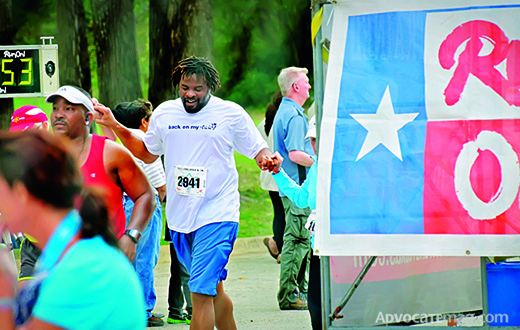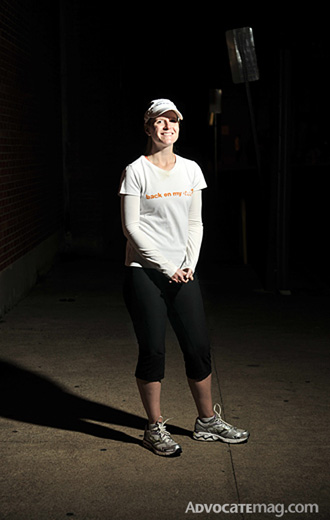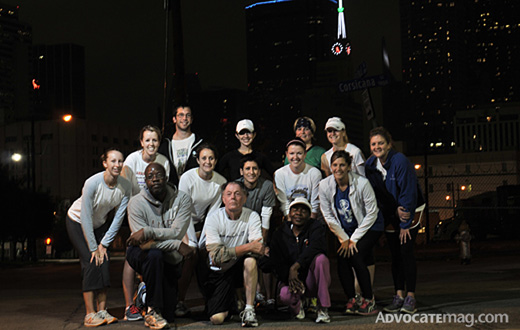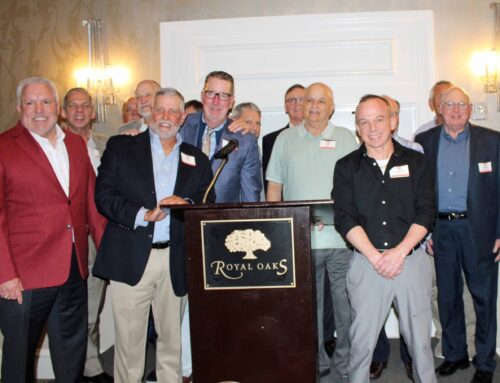These team members don’t just run the streets. They’ve lived on them.
[youtube]http://www.youtube.com/watch?v=bhcD_HTF9wE[/youtube]At 5:30 on a Wednesday morning at the corner of Corsicana and Park streets Downtown, two figures inside sidewalk sleeping bags snore, and a man in a thick hooded coat leans against The Bridge homeless shelter wall and puffs his cigarette. His gaze follows a few sweatshirt- and athletic-shoe-clad folks as they emerge from the building to join a similarly dressed group in the parking lot.
The bunch, 15 or so altogether, forms a wide circle. After a series of jumping jacks, stretches and a prayer — “God, grant me the serenity …” — they hit the streets.
Though they train during the wee dark hours, the Back on My Feet team, comprising homeless shelter tenants and volunteer runners, is gaining visibility around White Rock Lake.

Back on My Feet member Charles Smith finished the Dallas Running Club half marathon in 2 hours 30 seconds. Photo by Miranda Krebbs
They appear in groups — you know them by their crisp white “Back on My Feet” T-shirts — at most Dallas Running Club events, which are held at Winfrey Point or Norbuck Park at Northwest Highway and Buckner.
The organization enjoys a partnership with East Dallas running outfitter Run On!, which donates shoes and gear and drums up volunteer participation.
BOMF’s 6- to 9-month program partners with central Dallas shelters including The Bridge, Dallas LIFE Foundation and Salvation Army to engage homeless populations in running as an avenue to confidence and self-sufficiency.
“Everyone starts with one mile — most have to run-walk that first mile,” says Lea Velez, director of BOMF Dallas, which launched last February.
In October several members raced a 9.2-mile race at White Rock Lake’s The Loop 15k, and some ran the 13.1-mile course at the Dallas Running Club’s November half marathon, which starts in Lake Highlands and winds around the lake and through Lakewood.

Lea Velez leads a running group at The Bridge homeless shelter for those working to get back on their feet. Photo by Can Türkyilmaz
“It is amazing to see that type of progress take place. This kind of renews running for me,” says Velez, a university teacher with a background in social work and veteran of 36 marathons and four ironman triathlons. “I know that, personally, when I ran my first marathon, I felt that if I could get through some of the rough patches in the race, I could get through difficult things in other areas of my life.”
As the Wednesday morning runners pick up the pace, member Paula Turner lags behind. “Running’s not really my thing, but I like to come out and walk,” she says. “Lea (Velez) just ran a 26-mile race. If she can do that, I can come out and walk a couple miles.”
A few years ago Turner was living in a tent on the streets of Las Vegas.
“I came from a good family, my mother took me to the theater, we traveled — she raised me right. I had no one to blame for my problems but myself.”
After raising two children, she says, she developed a chemical addiction, which set off the problems that led to homelessness. (According to the 2010 census, about 31 percent of the homeless population reports “substance abuse” as the cause of their homelessness.)
Today, Turner is clean and for almost a year has been living at The Bridge. Her 25-year-old son, who has mental and physical disabilities, also is in The Bridge program.
The three-day-a-week pre-dawn exercise lends discipline and structure to Turner’s life, and she says she feels it is an important component in her overall rehabilitation, which also includes classes at El Centro College.
Group member Ed Fuller, who finishes his practice run out of breath, sweaty and with a smile on his face, says he is mentally stronger, physically healthier and has lost 50 pounds since joining Back on My Feet.
“The running hurts, but once the run is over, I feel really proud of what I’ve done. If don’t give up during the races all the times I wanted to give up, you know, why give up now? Keep pushing and by the time it’s over, you’ll feel good about what you did.”

Team Back on M Feet trains before dawn three mornings a week. Runners interested in learning more or volunteering with Back on My Feet can attend an upcoming orientation at Run On! Register at dallas.backonmyfeet.org. Photo by Can Türkyilmaz
Members who maintain 90 percent attendance during the initial stage of the program advance to the Next Steps phase, during which they are eligible for job and educational training through Back on My Feet.
The three Back on My Feet teams have about 50 members, and 75 percent have moved on to Next Steps. Since the club’s formation less than a year ago, 61 members have run races, 25 have obtained employment, 11 have found housing and 27 have enrolled in job training or academic classes.
Some, such as 47-year-old Gloria Z. — a former gang member and heroin addict who joined Back on My Feet while she was staying at The Bridge — continue with the group even after they have found a home.
“The program turned out to be like a rock for me — gave me strength and helped my self-esteem,” Gloria says.
She ran a four-mile race last summer when the Dallas Running Club made BOMF a race beneficiary at its Bloomin’ 4 Mile. The group members threw a housewarming party when Gloria moved into her first apartment.
“They brought all their warmth and loving care to my house,” Gloria says. “Everyone who runs, they are my angels.”
• Learn more at www.backonmyfeet.org.





